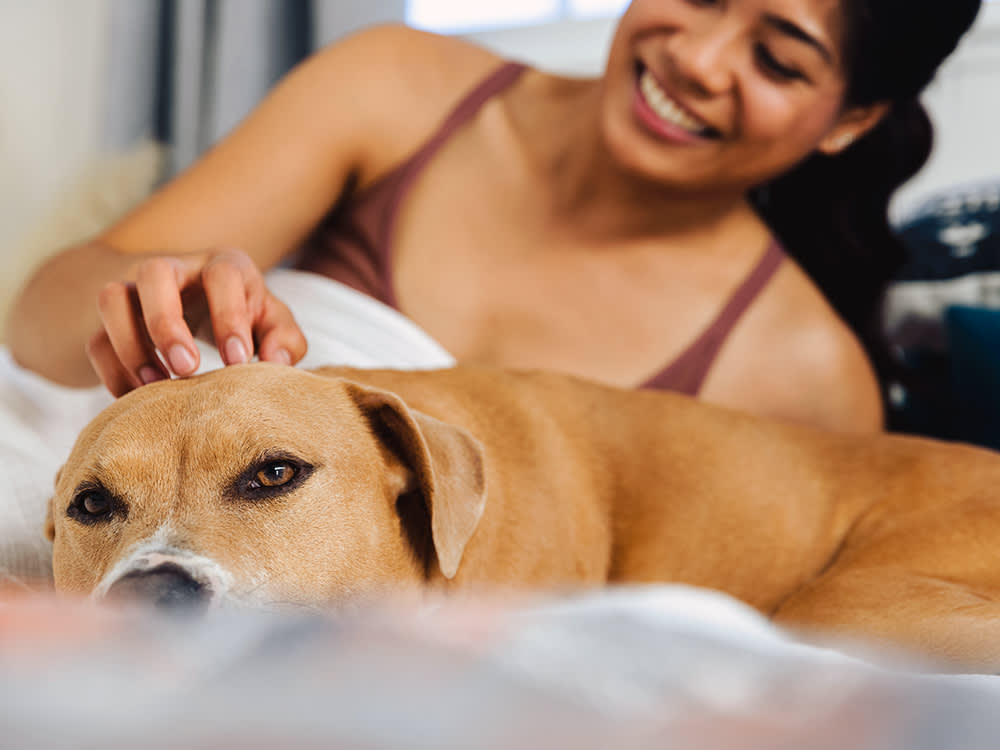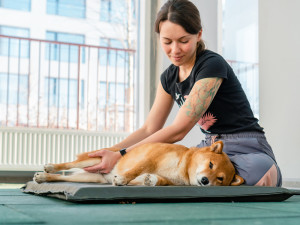How to Help Dogs With Intervertebral Disc Disease
If your dog has a herniated disc, acupuncture may be the key to relief.
If you've ever had a herniated disc in your back or neck, you know how painful it can be — and it's just as bad for dogs. Known as intervertebral disc disease in dogs (IVDD), aka a herniated or slipped disc, the condition can leave your dog in excruciating pain and unable to walk. Initially, the signs can be subtle: a hesitation around stairs, paws that knuckle under or cross over, nail scuffing, an arched back, and a tense abdomen. Some dogs may shy away from their food bowls to avoid bending their necks, or they may cry when picked up.
IVDD in dogs is usually managed with pain meds, physical therapy, and, in severe cases, surgery. But there's another remedy that could help: acupuncture. (Yep, you read that right.) Keep reading to learn everything you need to know about IVDD — plus, exactly how acupuncture may help.
Snap a pic of your pup’s teeth, and GREENIES™ will help you spot potential signs of oral health issues.
What is IVDD in Dogs?
IVDD is a common spinal problem in dogs that causes compression of the spinal cord and leads to weakness, pain, and sometimes paralysis. The condition is divided into two categories: Hansen type I and type II. Type I often swoops in suddenly, usually in younger, smaller dogs ages three to six. The center jelly of the vertebral disc, called the nucleus pulposus, degenerates, then ruptures and presses on the spinal cord.
Symptoms of Intervertebral Disc Disease in Dogs
Abnormal walking
Hesitation to climb stairs
Limping
Dragging paws (nails scuffing)
Neck or back pain (sensitive to the touch)
Hesitation to raise neck (avoiding bending their neck)
Tense muscles in the neck or abdomen
Stiff appearance
Reduced activity level
Whimpering or crying
Dog Breeds With Predisposition to IVDD
Not surprisingly, the chondrodystrophic breeds (dogs with short legs and long backs) — Dachshunds, Corgis, Lhasa Apsos, Shih Tzus, and Beagles — are predisposed to this type.
How much do you spend on your pet per year?
Type II, which is typically seen in large dogs like German Shepherds, Labradors, and Dobermans ages eight to ten, progresses more slowly. Though the disc doesn’t burst its center, it bulges between the vertebrae and impinges on the spinal cord, causing chronic pain and weakness.
Diagnosis of IVDD in Dogs
If your pup begins to show symptoms, your vet will start with x-rays to rule out fractures, bone infections, and cancers. But a contrast myelogram, CT, or MRI (all of which are often done at specialty centers) is often needed to visualize the spinal cord and determine the nature and location of the problem.
In addition to type, there are several IVDD stages that are graded by severity. Typically, grade I involves pain; grade II, unsteadiness; grade III, weakness that prevents standing or walking; grade IV, paralysis with the ability to feel deep pain when the toes are pinched; and grade V, complete paralysis with loss of deep pain.
Treatment for IVDD in Dogs
Dogs with IVDD (grades I through IV) are managed with pain meds, muscle relaxants, and strict rest for up to a month, and are often referred for physical therapy or laser treatments. Depending on the duration of neurological deficits and amount of pain, surgery may also be recommended for dogs with grades II, III, and IV intervertebral disc disease. Because the disease can change quickly, even dogs diagnosed with lower-grade IVDD need regular exams to ensure that the condition doesn’t progress.
When a dog is completely unable to walk, decisions have to be made swiftly. Dogs who stay in the grade V intervertebral disc disease stage longer than 48 hours often remain paralyzed despite intervention, while up to 50% of those who have surgery in the first 24 hours may regain their ability to walk.
IVDD surgery removes compromised discs, hemorrhage, and adjacent bone compressing the spinal cord. With severe disease, it’s the best chance for a dog to walk again. It does, of course, also entail expenses and risks that not everyone is able or willing to take, which begs the question: What other options are there?
IVDD Treatment Without Surgery
Thankfully, veterinarians have studied other modalities to treat IVDD, and acupuncture is one of them. In fact, a studyopens in new tab lead by A.M. Hayashi found that dogs of all IVDD grades recovered more quickly with electroacupuncture (EAP) combined with a standard Western medical approach than Western treatment alone.
Another studyopens in new tab reported that dogs receiving EAP and pain medications after surgery for acute IVDD were less likely to need higher doses of pain meds during the first 12 hours than those who received meds alone. These patients also had significantly lower pain scores 36 hours after treatment.
Separate researchopens in new tab compared three treatment options for dogs with IVDD who had severe neurologic deficits for longer than 48 hours: decompressive surgery (DSX), EAP, and DSX followed by EAP. The study, led by J.G.F. Joaquim, showed that EAP was more effective than DSX and EAP combined, and that DSX alone was the least successful. The studied dogs had severe, long-standing IVDD in the thoracic and lumbar spine, and in the past, their prognosis would have been dismal.
How Does Acupuncture Treatment for IVDD Work?
A veterinarian certified in acupuncture inserts small, sterile needles into specific acupuncture points to stimulate muscles, nerves, circulation, and the immune system. For IVDD, one needle may be placed at the top of the spine by the shoulders, and a second above the pelvis, which moves the qi and stagnated energy caused by the disc disease.
Functional MRIs reveal that acupuncture activates pain-associated brainstem regions. The specific mechanism of acupuncture on IVDD has not yet been fully explained, but it’s surmised that it reduces local swelling, inflammation, and pain; decreases cord compression, scar formation, and tissue oxygen deprivation; and restores damaged nerves.
When compared to the use of needles alone, EAP has been found to increase the body’s response to acupuncture. In EAP, needles in the skin are connected by metal clips. Electro-impulses move between the clips and into the needles, producing sensations that range from a tingling to a vibration. Frequency and intensity are determined by the type of condition being treated. Sessions usually last from 10 to 30 minutes, and dogs often fall asleep during treatment.
EAP has a cumulative effect and is typically prescribed as a series of treatments, every one to two weeks for at least a few months. Appropriate Chinese herbal formulas are often prescribed at the same time to reduce pain and enhance the effects of acupuncture. Dogs then proceed to undergo maintenance acupuncture one to three times monthly to prevent a recurrence of symptoms.
Ideally, your dog will never go through the pain of IVDD. But if they do, it’s good to know that adding acupuncture to their treatment plan may help them get back on all fours sooner rather than later.









